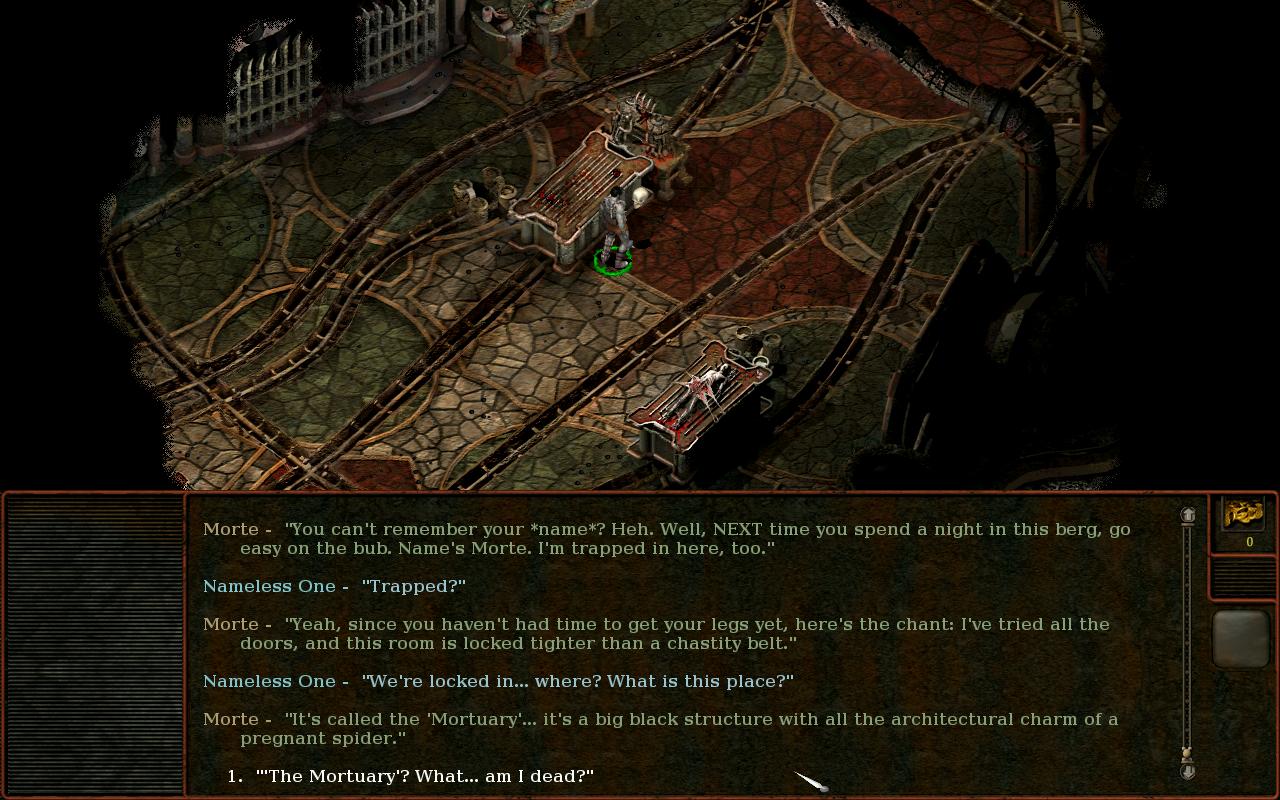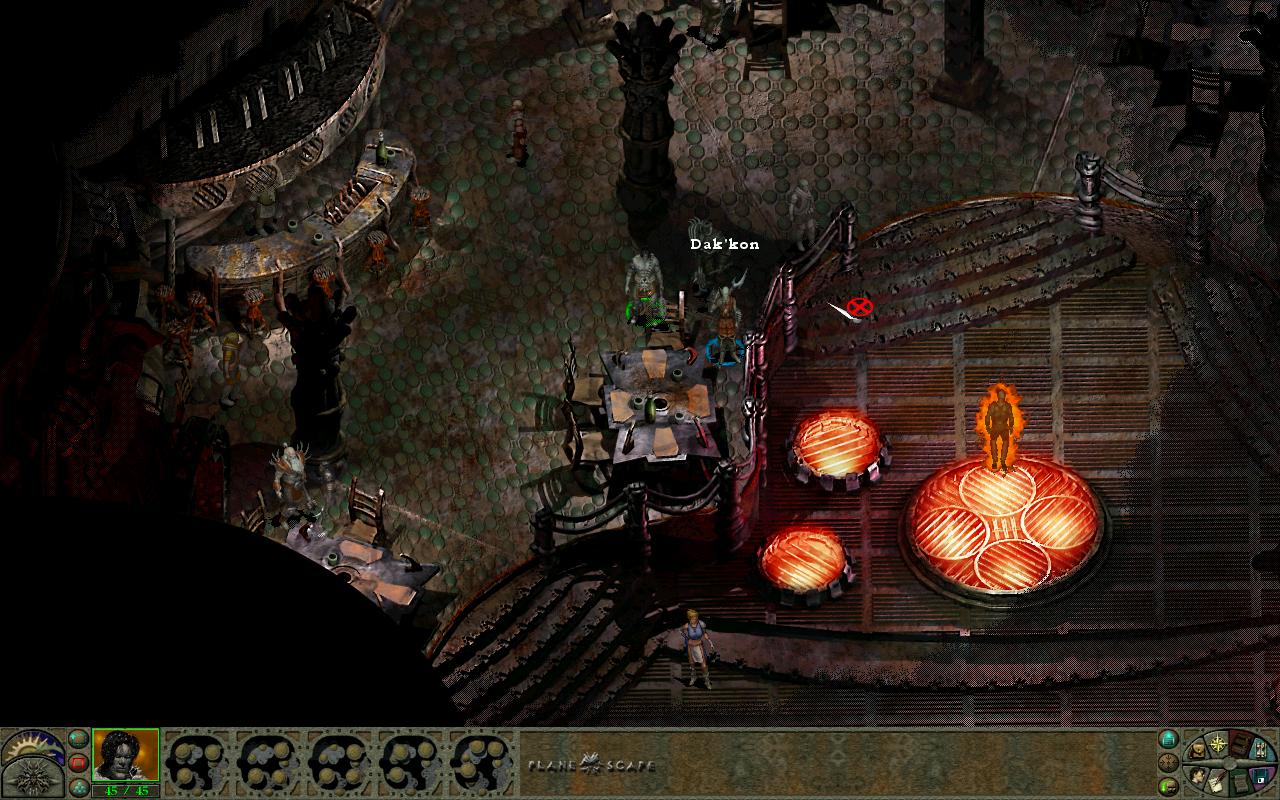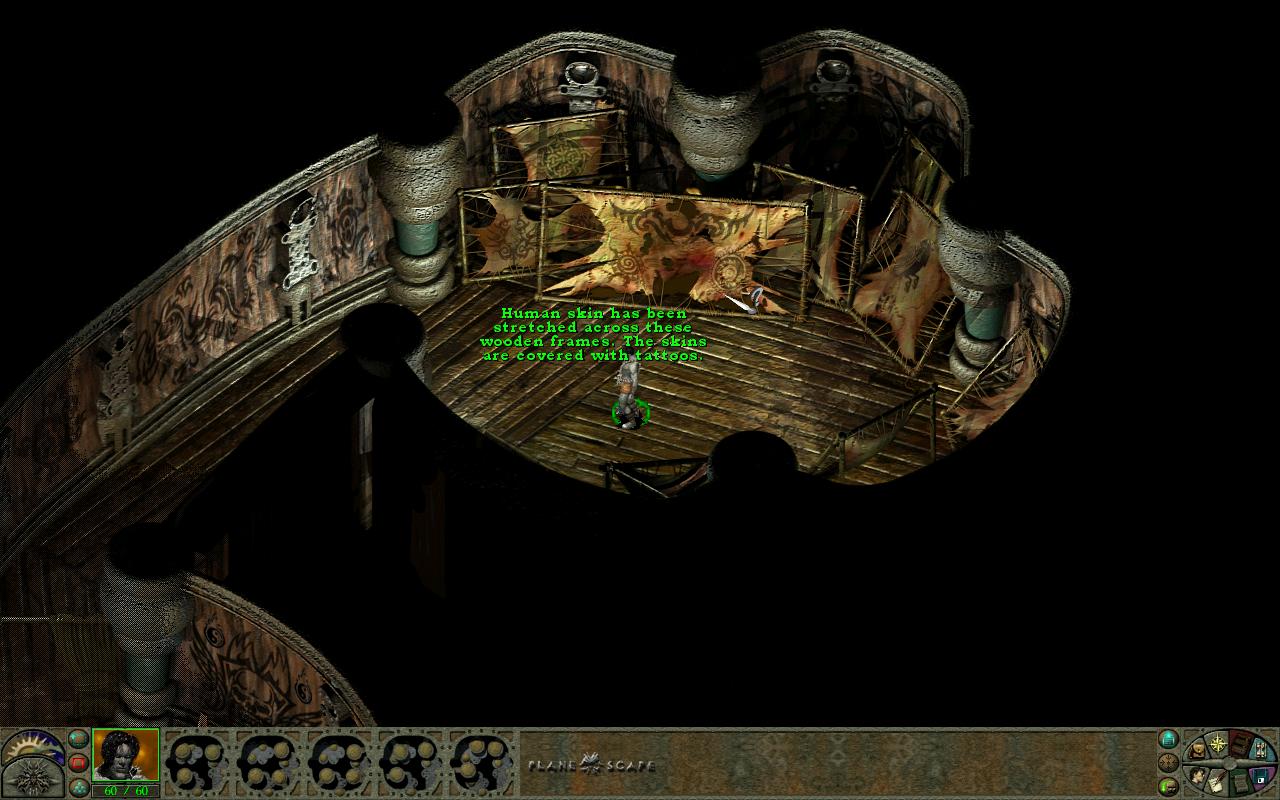Trending
Opinion: How will Project 2025 impact game developers?
The Heritage Foundation's manifesto for the possible next administration could do great harm to many, including large portions of the game development community.

Featured Blog | This community-written post highlights the best of what the game industry has to offer. Read more like it on the Game Developer Blogs or learn how to Submit Your Own Blog Post
A look at one of Planescape: Torment's more famous dialogue trees: Dak'kon's spiritual crisis.

Videogames are filled with conversations. These range from simple barks to deep and varied dialogue trees, but they're fairly prevalent regardless of implementation.
And it makes sense, too. People like stories, and stories are built on characters.
Despite this fairly natural desire for dialogue, games used to be pretty devoid of conversations. This struck me as particularly odd in RPG's where groups of people set out on a quest to save the world. After all, one would assume the journey would foster some banter and comradery.
Cutscenes eventually filled the void, but it took a while for another mechanism to catch on: letting the player manually choose to speak to his followers.
Planescape: Torment was one of the first titles to do this, and its discussions on the Circle of Zerthimon remain one of my favourite examples of player-initiated dialogue.
"No wonder my back hurts; there's a damn novel written there."
Planescape: Torment opens up with its scarred protagonist, The Nameless One (TNO), waking up in a morgue. A talking skull quickly floats by initiating a conversation.

Torment 2011-04-02 11-27-28-83
We soon find out that Planescape: Torment is not afraid of being verbose. Dialogue is plentiful and it's buffeted by descriptions, creating entire paragraphs that read like a novel. The Planescape cant -- 19th Century British slang -- adds further colour to the text.
Morte, the talking skull, informs us that TNO is effectively immortal as he resurrects each time he dies. The caveat is that he risks losing his memories whenever this happens, which is exactly how the game begins.
"Here? This is the Smoldering Corpse, though the person smoldering ain't dead yet."
TNO's only clues to his past are rather vague; all he knows is that he's missing a journal and should seek out a man named Pharod.

Torment 2011-04-02 11-55-37-07
Sigil is a wondrous city, but in some ways it's not that much different from a typical fantasy hub. To get a few quick answers, the easiest solution is to visit the local tavern.
The gruesome Smoldering Corpse bar is filled with all sorts of interesting characters, one of whom is noted to be observing TNO. His name is Dak'kon, and he's a withered old githzerai who wields a shimmering glaive.
Talking to Dak'kon reveals that his weapon, a karach, is shaped and sharpened by his mind. The karach represents a zerth, a follower of Zerthimon, but Dak'kon's blade is somewhat degraded due to a spiritual crisis. The githzerai dwell in the ethereal world of Limbo, forging their surroundings from clear thought, so this is a fairly significant issue.
Unfortunately Dak'kon cannot answer TNO's immediate questions, but when the conversation ends, he offers to accompany us on our journey.
"This is his gallery. He says that he *knows* you as his canvas. He shows respect to your strength with his admiration." Dak'kon is silent for a moment. "Then he insults you by giving you his pity."
The initial conversation options with Dak'kon are limited, but talking to other githzerai in his presence reveals more about him. We pick up on the fact that Dak'kon's sullen disposition is a result of what's seen as a terrible disgrace by his people.
What's more, Dak'kon is purposefully hiding things from us.

Torment 2011-04-02 13-26-46-69
Fell's grotesque backstage gallery consists of TNO's moulted skin.In the Weeping Stone Catacombs, TNO comes across a severed arm that once belonged to his previous incarnation. The arm can be taken to Fell's parlour to ask the Dabus about the tattoos that adorn it. If Dak'kon is chosen to translate Fell's rebus dialogue, TNO can detect that the seemingly honourable gith is actually lying.
When confronted, Dak'kon states that he will not say any more in the parlour. The issue can be pursued later on, at which point we discover that Dak'kon has actually traveled with one of TNO's previous incarnations. This revelation leads to the rather unique Xachariah subquest that sheds more light on TNO's own past.
"*Know* that I am not a teacher in this, but *know* that I can serve as a guide."
When TNO asks Dak'kon about his magic -- the 'Art' -- the gith replies that he does not know how it manifests itself in humans. However, if TNO were able to use it, he could learn more of it from Dak'kon.
This is achieved by completing Mebbeth's sidequests and becoming a mage. While a mage, TNO can study under Dak'kon, and also switch classes by talking to him.
"To learn, you must *know* the People. To *know* the People, you must *know* the Unbroken Circle of Zerthimon."
The Unbroken Circle of Zerthimon is a device composed of a series of interlocking stone carvings. It's a clockwork bible of sorts that Dak'kon carries with him wherever he goes.
Examining the Circle as a mage opens up a dialog box. Each level of the Circle tells a different tale of the githzerai race, its genesis, mass enslavement, and eventual rebellion. It reveals the rise of Zerthimon and the eons of suffering him and his people endured. The Circle teaches how the zerth came to learn and master themselves, and how enslavement became their greatest anathema.
"Endure. In enduring, grow strong."
The full transcript of the Circle's teachings can be found here, although it doesn't contain Dak'kon's and TNO's commentaries.
Reading and learning the Circle comes across as a ritual; TNO must unlock each layer himself -- as shown by Dak'kon -- and talk to the gith after each session to discuss it. If TNO's wisdom statistic is high enough, the proper lesson can be gleaned. This rewards the party with some experience, and a unique spell disk for TNO that magically slides out of the artifact without diminishing its weight or content.

Torment 2011-04-02 23-42-26-74
Discussing the Circle in front of the Tomb for the Planes, it's finally revealed what plagues Dak'kon with doubt: he fears that Zerthimon was just a puppet of his enemies.This pattern goes on for six lessons until it's revealed that Dak'kon himself does not *know* the full Circle.
"You performed a great service for me. In so doing, you enslaved me."
With with the sixth layer, both TNO and Dak'kon receive a new spell. To unlock the seventh and eighth layers, TNO's intelligence must be high enough to work the mechanism, and his wisdom high enough to understand the lessons themselves.
This is a nice transition of student-to-teacher, and ultimately rewards Dak'kon with some permanent stat increases. These in turn affect the karach blade, empowering it with each increment.
The lessons of the Circle also lead to the truth behind Dak'kon's and TNO's past.
The ruthless "practical" incarnation originally found Dak'kon close to death in the world of Limbo. He desired the karach blade, so he ensnared the gith in a devious trap. By constructing the Unbroken Circle of Zerthimon and speaking of its lessons, he showed Dak'kon a glimmer of hope to his spiritual ailment. In exchange, Dak'kon promised to follow TNO until his death, effectively becoming bound to the immortal for all time.

Torment 2011-04-03 12-03-08-08
Although purely text-based, this was one of the most moving moments I had ever experienced in a videogame.This enslavement constituted the greatest sacrilege for the zerth, yet it was the only salve for Dak'kon's moribund soul. By completing the Circle, we finally brought him the resolution he so desperately craved.
"*Know* that there is now nothing left that I may surrender except my life."
Although still bound to TNO, completing the Unbroken Circle of Zerthimon allowed us to strengthen Dak'kon's body, mind and spirit.
The process also facilitated character development and character progression. It was meaty, and deep, and unfolded gradually as the game progressed. It sparked numerous discussion that are still ongoing to this day, and it's held up as a prime example of what made Planescape: Torment such a compelling title.
And it was all for a completely optional character.
Radek Koncewicz is the CEO and creative lead of Incubator Games, and also runs the game design blog Significant-Bits.
Read more about:
Featured BlogsYou May Also Like